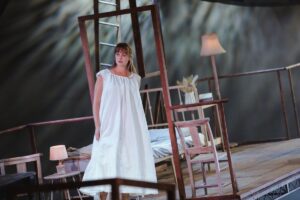Opera Holland Park’s 2025 season opens with Wagner’s The Flying Dutchman, closes with Verdi’s La Traviata, and, in between, presents Donizetti’s Lucia di Lammermoor.
All three productions are directed by women — and at the heart of each is a female character facing profound challenges shaped by the men around her.
In every case, the music is not merely accompaniment but the engine of the drama, giving voice to the women’s inner strength, conflict, and yearning. And in all three stories, the heroine dies.
In these operas, the orchestra does more than support the singers — it becomes a narrator in its own right. Each composer uses instrumental colour, rhythm, and motif to express what the characters cannot say aloud: fear, desire, defiance, or impending doom. Whether it’s the storm-tossed brass that heralds the Dutchman’s arrival, the ghostly sounds from the flute (substituting glass harmonica) that traces Lucia’s descent into madness, or the fragile strings that wither alongside Violetta’s dying breath, the orchestral writing reveals the psychological landscape of each heroine. The music doesn’t just accompany tragedy — it creates it.
Each of these operas is anchored by a woman whose fate shapes the course of the drama. Senta, in The Flying Dutchman, is a dreamer obsessed with the legend of the cursed sailor — a woman willing to sacrifice everything for an ideal of salvation. Lucia, in Lucia di Lammermoor, is a young woman trapped in a brutal family conflict, whose love is forbidden and whose mind ultimately collapses under pressure. And Violetta, the heroine of La Traviata, is a celebrated courtesan who dares to love sincerely, only to be punished by society’s moral hypocrisy. Each woman inhabits a different world — myth, melodrama, realism — and yet all three face the same inescapable truth: their voices may soar, but they are never fully in control of their own destiny.
Although they live in vastly different worlds — a mythical seaport, a Scottish manor, and the salons of Paris — Senta, Lucia, and Violetta are united by a strikingly similar dramatic function: each is called upon to sacrifice herself for the sake of a man’s future, reputation, or redemption. In The Flying Dutchman, Senta is portrayed as very young — and in this recent production, her obsession with the ghostly sailor seems less like a romantic choice than a psychological consequence of her father’s ambition. Her father hopes to marry her off to the Dutchman for his wealth, masking material interest in the language of mythic destiny. Lucia, likewise, is emotionally manipulated by her brother, who sees her marriage as the key to restoring the family’s standing. And Violetta, perhaps most heartbreakingly, is asked by her lover’s father to give up her happiness in order to preserve his family’s honour. In all three operas, we find women whose personal agency is slowly eroded under the weight of male expectation — a reality the composers render not only through the libretto but even more powerfully through the music.
These portrayals remain unsettlingly resonant today. While the settings and conventions may be historical or fantastical, the emotional stakes — the pressure on women to prioritise male reputations, the cost of emotional honesty, the weight of societal judgement — are strikingly contemporary. What makes these operas endure is not simply their drama, but the way each composer amplifies that drama through music. Each woman’s voice becomes the battleground where freedom, identity, and sacrifice are negotiated — and each score reveals how fragile that space truly is.

Senta’s music, for example, is filled with longing and conviction — but it is also haunted. Her ballad recounting the Dutchman’s fate is one of Wagner’s most memorable motifs: noble, aching, and almost delusional in its intensity. It is music that reaches out to something unreachable. But when Senta agrees to bind herself to the Dutchman, it’s unclear whether she is choosing freely or fulfilling a mythic script imposed on her — much like Lucia, whose most famous aria is sung not in strength but in madness.
Lucia’s mad scene, framed by eerie, floating lines from a glass harmonica or flute, is a masterpiece of musical psychology. Donizetti allows us to enter her disintegrating mind not with chaos but with beauty — as though the only space Lucia can safely inhabit is one divorced from reality. She finds freedom only in collapse. The orchestra does not contradict her; it follows her, echoing her descent with tragic intimacy.
Violetta, by contrast, dies in a state of lucidity. Her voice, once brilliant and defiant in “Sempre libera”, softens in her final scene into fragile lyricism. The orchestration thins to the barest textures, and the recurring motifs — love, sacrifice, regret — return in hushed, almost translucent form. Unlike Senta or Lucia, she has no illusions left, and no madness to escape into. Her tragedy is rooted in full awareness.
Though these operas end in silence, each heroine’s voice tells a profoundly different story — not just through what she sings, but through how her composer supports or undermines her through the music.
Donizetti gives Lucia technical brilliance at the moment of greatest collapse. In the mad scene, colouratura — often used to display vocal virtuosity — becomes a dramatic tool. Her trills, leaps, and delicate high notes no longer dazzle for their own sake; they tremble on the edge of sanity. Crucially, the orchestration doesn’t push against her; it gives her space, echoing her disordered thoughts with a gentle eeriness. The use of the glass harmonica (or flute, in some versions) gives her voice an unearthly double — like a spirit shadowing her. Lucia’s strength, paradoxically, is revealed through her break from reality: the music allows her a tragic kind of agency in madness, even as her world falls apart.
Verdi gives Violetta a different arc — one from glittering defiance to exposed vulnerability. In Act I, her vocal lines are dazzling, fast, almost impossibly light — especially in “Sempre libera”, where she asserts her freedom while the orchestra insists, via Alfredo’s offstage theme, that love is already pulling her elsewhere. As the opera progresses, Verdi deepens her emotional palette: her Act II sacrifice scene with Germont is one of the most emotionally complex exchanges in opera. Her vocal line slows, the tessitura – drops, and her tone darkens as she absorbs what is being asked of her. In her final scene, the orchestration recedes to a whisper; the fragility of the strings mirrors her fading pulse. Violetta’s strength is not in madness or sacrifice alone, but in her lucid endurance. She sings with complete clarity — and still chooses to love.
Wagner’s Senta occupies a more mythic sound world, but one no less human. Her ballad in Act II is framed as a performance — she sings the legend of the Dutchman to others — but her belief becomes so consuming that we feel it’s sung more to herself than anyone else. Wagner’s orchestration is bolder, thicker, more symphonic than Donizetti or Verdi, yet he still allows space for intimacy. The Dutchman’s motif — dark, thunderous — contrasts sharply with the yearning nobility of Senta’s. When their musical worlds converge, it’s not a romantic duet, but a collision of fates. In the final moments, as she throws herself into the sea (or in this production, disappears into dream), the music finally resolves. Her sacrifice frees the Dutchman — but whether this act is heroic or tragically inevitable remains open. Wagner gives her grandeur, but not freedom.
That these operas are being staged at Opera Holland Park this season by women directors feels especially significant. Though each work was composed by a man, and each heroine written within the confines of 19th-century expectations, the music speaks across time — often more honestly than the libretto — about desire, constraint, resilience, and loss. Under female direction, these stories can be reframed not simply as tragic fates, but as emotional and psychological journeys with new relevance. Whether Senta, Lucia, or Violetta is seen as victim, redeemer, or heroine, the music ensures they are never silent. For audiences today — especially younger ones encountering opera for the first time — these women offer not only unforgettable arias, but windows into how music can illuminate the most intimate corners of human feeling.

